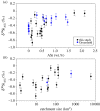Silicon isotopes in Arctic and sub-Arctic glacial meltwaters: the role of subglacial weathering in the silicon cycle
- PMID: 31534420
- PMCID: PMC6735475
- DOI: 10.1098/rspa.2019.0098
Silicon isotopes in Arctic and sub-Arctic glacial meltwaters: the role of subglacial weathering in the silicon cycle
Abstract
Glacial environments play an important role in high-latitude marine nutrient cycling, potentially contributing significant fluxes of silicon (Si) to the polar oceans, either as dissolved silicon (DSi) or as dissolvable amorphous silica (ASi). Silicon is a key nutrient in promoting marine primary productivity, contributing to atmospheric CO2 removal. We present the current understanding of Si cycling in glacial systems, focusing on the Si isotope (δ30Si) composition of glacial meltwaters. We combine existing glacial δ30Si data with new measurements from 20 sub-Arctic glaciers, showing that glacial meltwaters consistently export isotopically light DSi compared with non-glacial rivers (+0.16‰ versus +1.38‰). Glacial δ30SiASi composition ranges from -0.05‰ to -0.86‰ but exhibits low seasonal variability. Silicon fluxes and δ30Si composition from glacial systems are not commonly included in global Si budgets and isotopic mass balance calculations at present. We discuss outstanding questions, including the formation mechanism of ASi and the export of glacial nutrients from fjords. Finally, we provide a contextual framework for the recent advances in our understanding of subglacial Si cycling and highlight critical research avenues for assessing potential future changes in these environments.
Keywords: glaciers and ice sheets; silicon cycle; silicon isotopes; subglacial weathering.
Conflict of interest statement
We declare we have no competing interests.
Figures





Similar articles
-
Insights into silicon cycling from ice sheet to coastal ocean from isotope geochemistry.Commun Earth Environ. 2025;6(1):305. doi: 10.1038/s43247-025-02264-7. Epub 2025 Apr 19. Commun Earth Environ. 2025. PMID: 40260398 Free PMC article. Review.
-
The silicon cycle impacted by past ice sheets.Nat Commun. 2018 Aug 10;9(1):3210. doi: 10.1038/s41467-018-05689-1. Nat Commun. 2018. PMID: 30097566 Free PMC article.
-
Ice sheets as a missing source of silica to the polar oceans.Nat Commun. 2017 Jan 25;8:14198. doi: 10.1038/ncomms14198. Nat Commun. 2017. PMID: 28120824 Free PMC article.
-
Silicon Isotope Geochemistry: Fractionation Linked to Silicon Complexations and Its Geological Applications.Molecules. 2019 Apr 10;24(7):1415. doi: 10.3390/molecules24071415. Molecules. 2019. PMID: 30974887 Free PMC article. Review.
-
A Close Look at Dissolved Silica Dynamics in Disko Bay, West Greenland.Global Biogeochem Cycles. 2025 Jan;39(1):e2023GB008080. doi: 10.1029/2023GB008080. Epub 2025 Jan 1. Global Biogeochem Cycles. 2025. PMID: 39759391 Free PMC article.
Cited by
-
Probing surface Earth reactive silica cycling using stable Si isotopes: Mass balance, fluxes, and deep time implications.Sci Adv. 2023 Dec 8;9(49):eadi2440. doi: 10.1126/sciadv.adi2440. Epub 2023 Dec 6. Sci Adv. 2023. PMID: 38055818 Free PMC article.
-
The Influence of Glacial Cover on Riverine Silicon and Iron Exports in Chilean Patagonia.Global Biogeochem Cycles. 2020 Dec;34(12):e2020GB006611. doi: 10.1029/2020GB006611. Epub 2020 Dec 17. Global Biogeochem Cycles. 2020. PMID: 33519063 Free PMC article.
-
Limits to timescale dependence in erosion rates: Quantifying glacial and fluvial erosion across timescales.Sci Adv. 2024 Dec 20;10(51):eadr2009. doi: 10.1126/sciadv.adr2009. Epub 2024 Dec 20. Sci Adv. 2024. PMID: 39705349 Free PMC article.
-
Patterns in Microbial Assemblages Exported From the Meltwater of Arctic and Sub-Arctic Glaciers.Front Microbiol. 2020 Apr 15;11:669. doi: 10.3389/fmicb.2020.00669. eCollection 2020. Front Microbiol. 2020. PMID: 32351489 Free PMC article.
-
Benthic Dissolved Silicon and Iron Cycling at Glaciated Patagonian Fjord Heads.Global Biogeochem Cycles. 2022 Nov;36(11):e2022GB007493. doi: 10.1029/2022GB007493. Epub 2022 Nov 25. Global Biogeochem Cycles. 2022. PMID: 36582664 Free PMC article.
References
-
- Hawkings JR, et al. 2015. The effect of warming climate on nutrient and solute export from the Greenland Ice Sheet. Geochem. Perspect. Lett. 1, 94–104. (10.7185/geochemlet.1510) - DOI
-
- Lawson EC, et al. 2014. Greenland Ice Sheet exports labile organic carbon to the Arctic oceans. Biogeosciences 11, 4015–4028. (10.5194/bg-11-4015-2014) - DOI
-
- Meire L, et al. 2016. High export of dissolved silica from the Greenland Ice Sheet. Geophys. Res. Lett. 43, 9173–9182. (10.1002/2016GL070191) - DOI
Publication types
Associated data
LinkOut - more resources
Full Text Sources

